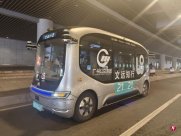
In recent years, China has accelerated industrial layout in many places, from developing and testing of auto companies, to the infrastructure construction of autonomous driving, and the introduction of policies.The competition in the field is becoming more and more fierce.
Specify, avoid, turn around, brake ... On the road of Yuejiang, Guangzhou, autonomous vehicles are driving in the traffic flow, parked steadily on the platform, and after loading passengers, slowly close the door and start again.
This is the trial operation of the autonomous driving minibus launched by Guangzhou in April this year. After the citizen appoints, the two fixed lines can take a free experience.The driving section belongs to the busy areas of Guangzhou. The vehicles need to deal with the complex scenes on the road independently and complete the normal passenger's procedures for getting on and off.
The mini -chip with eight people is unique. Except for the position of the two security officers, the actual passenger capacity of each car is only six.Although it is autonomous driving, each car is currently equipped with a safety officer. When the vehicle is judged and driving, the operating status and road scene of the vehicle are observed in real time.A security officer told Lianhe Zaobao that in the past few months of the trial operation of Guangzhou's autonomous driving, only a few cases need to be artificially intervene, such as encountering serious traffic jams.
After 20 minutes, the vehicle completed the circular fixed route of about nine kilometers. After the orderly trail was changed in an orderly manner, the vehicle stopped steadily and returned to the original site.
China is competing in many places to promote the development of intelligent connected cars, and actively support the development of the driverless industry with the help of intelligent connected technology. Application practice scenarios like Guangzhou are staged at the same time in different cities.In Made in China 2025 released by the State Council of China in 2015, the development of intelligent connected cars was rising to the height of the national strategy. After this, a series of support policies were launched from the central to the local area to promote the progress of driverless technology and commercialization.
In recent years, China has accelerated its industrial layout in many places. From the research and development and experiment of auto companies, to the infrastructure construction of autonomous driving, and the adjustment of policy introduction, the competition of major cities in the field of self -driving is becoming increasingly fierce.
The automotive industry has been the head of the three pillar industries of Guangzhou for many years.In 2020, Guangzhou launched a pilot of intelligent connected car road testing. It was one of the first cities in China to carry out autonomous car road testing.The city currently conducts road tests such as autonomous driving taxis, autonomous driving minibus, autonomous driving smart trucks, and autonomous sanitation vehicles in some areas, and has continuously accelerated.
According to the official WeChat of the Guangzhou Transportation Bureau, Guangzhou opened the intelligent connected car test road in the first half of this year, an increase of 57.6%compared with the end of last year, and the mileage of autonomous driving was about 2.07 million kilometers.10,000 kilometers.
The General Office of the Ministry of Transportation announced the pilot projects (autonomous driving and intelligent shipping directions) of 18 first batch of intelligent transportation pilot application last month.According to the publicity, this year and next, Guangzhou will invest 260 self -driving cars to form a summary report of the pilot work. Focusing on the service scenarios of autonomous driving cities, we will compile technical guidelines or standards for no less than two.
Beijing, Shanghai, Shenzhen, Changsha, Suzhou, Chongqing and other places are also accelerating the demonstration and application of autonomous vehicles, and issued policies to encourage the pilot of commercialization of autonomous driving.As of now, more than 40 provinces and cities have issued corresponding management measures or implementation rules.
Among them, Shenzhen began to implement the regulations on the management of intelligent connected automobiles in Shenzhen Special Economic Zone on August 1 to centrally solve key problems such as unable to access, registered, unable to register on the road, and road transportation.The first domestic regulations on intelligent connected vehicles.
The accelerated development of commercial applications
Driven by the active support and promotion of local governments, Chinese companies have continuously accelerated the pace of self -driving driving.According to the data of the Economic Daily, as of now, there are more than 6,000 market entities on the Chinese autonomous driving industry chain, and the industry has formed ten major categories of autonomous taxi, bus, trucks, end logistics, and sanitation.
Analyst analyst of the car travel industry, Jiangshanmei, was analyzed in an interview with Lianhe Morning Post that China ’s intelligent connected cars are currently in the stage of combining driving assistance (L2) to the condition of conditional autonomous driving function (L3).The use of intelligent connected enterprises into a variety of application scenarios of passenger cars and commercial vehicles.
Jiangshanmei said that the trend of Chinese passenger cars intelligent networking is significant. As of September this year, the number of passenger cars with intelligent auxiliary driving functions in the country has reached 2.28 million units, with an penetration rate of 32.4%, a year -on -year growth rate, a year -on -year growth rateIt reaches 46.2%.In terms of commercial vehicles, intelligent connected cars have gradually entered the commercial stage, and more related companies have chosen a gradual intelligent connected development model. Smart connected commercial vehicles are currently applied more in closed parks, mining areas, port areas, and ports, and ports, port areas, port areas, and ports, and ports, port areas, ports, and ports, port areas, port areas, port areas, and ports, and ports, port areas, port areas, and ports, and port areas, port areas, and ports, and port areas, port areas, port areas, and ports, and ports, port areas, port areas, and ports, and port areas.In highway and other scenarios.
Intelligent connected cars are still in the early stage of development, and long -term pilots need to be piloted. If the industry must truly achieve a market -oriented breakthrough, it also faces many challenges.In addition to the formulation of policies and norms, cost control, and reasonable planning of driving areas, the maturity and improvement of technology are also one of the difficulties.
Jiangshanmei said that China ’s intelligent connected cars will move towards the coordination of cars cloud, but at present, intelligent connected cars still have problems with immature technology and frequent safety accidents.Breakthrough requires higher -level and safer autonomous driving technology as the basis.
She said that this means that related intelligent connected car companies need more driving data and higher accuracy to monitor the monitoring capabilities.Therefore, the construction of road -side intelligent infrastructure that can improve the dynamic monitoring capabilities of intelligent connected cars and the development of smart transportation is an indispensable factor to achieve breakthroughs in autonomous driving technology.



